Burlington Coat Factory Bundle
Who Really Owns Burlington Coat Factory?
Understanding the ownership structure of a major retailer like Burlington Coat Factory is crucial for investors and business strategists alike. From its humble beginnings to its current status as a retail powerhouse, Burlington's journey has been marked by significant shifts in ownership. Examining these changes reveals insights into the company's strategic decisions and future prospects. Delving into the details of Burlington Coat Factory SWOT Analysis can also provide valuable context.
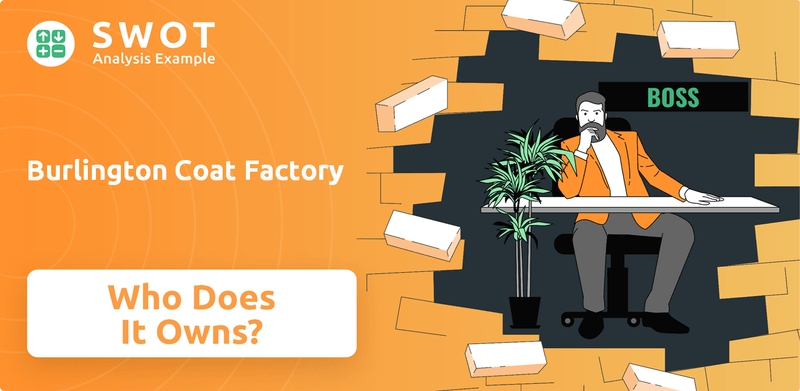
This exploration into Burlington ownership will unravel the evolution from its founders to its current stakeholders. We'll uncover how the Burlington parent company has navigated private equity acquisitions and public offerings, highlighting the key players who shape its direction. We'll analyze the influence of major shareholders and the role of the Burlington CEO and board of directors in driving the company's performance, making it essential reading for anyone interested in the Burlington Coat Factory's financial performance and future.
Who Founded Burlington Coat Factory?
The story of Burlington Coat Factory began in 1972. The company was founded as a family-run business, with Monroe Milstein and his wife, Henrietta, at the helm. Henrietta, a librarian, provided a significant portion of the initial investment, demonstrating the family's commitment to the venture.
Monroe Milstein, along with his father Abe, brought experience in the wholesale and retail outerwear business. They acquired a former factory outlet in Burlington, New Jersey, for $675,050. This marked the beginning of what would become a large retail chain.
Initially, the focus was on wholesale coat sales. However, to reduce reliance on seasonal demand, the Milsteins expanded the merchandise. They added clothing, accessories, and other items to broaden their appeal. This strategy helped evolve the business from a seasonal outerwear seller to a more diversified off-price retailer.
In 1983, the company, then known as Burlington Coat Factory Warehouse Corporation, went public. The Milstein family retained a majority stake in the company. This move provided capital for expansion and growth.
The early ownership of Burlington Coat Factory was primarily controlled by the Milstein family. The initial public offering (IPO) in 1983 allowed the company to raise capital while the Milsteins maintained a significant ownership share. This ensured the family's vision continued to guide the company's direction.
- The Milstein family founded the company in 1972.
- Henrietta Milstein's savings provided a large portion of the initial down payment.
- The IPO occurred in 1983, with the Milstein family maintaining control.
- The company expanded its merchandise beyond coats to reduce seasonal dependence.
Burlington Coat Factory SWOT Analysis
- Complete SWOT Breakdown
- Fully Customizable
- Editable in Excel & Word
- Professional Formatting
- Investor-Ready Format
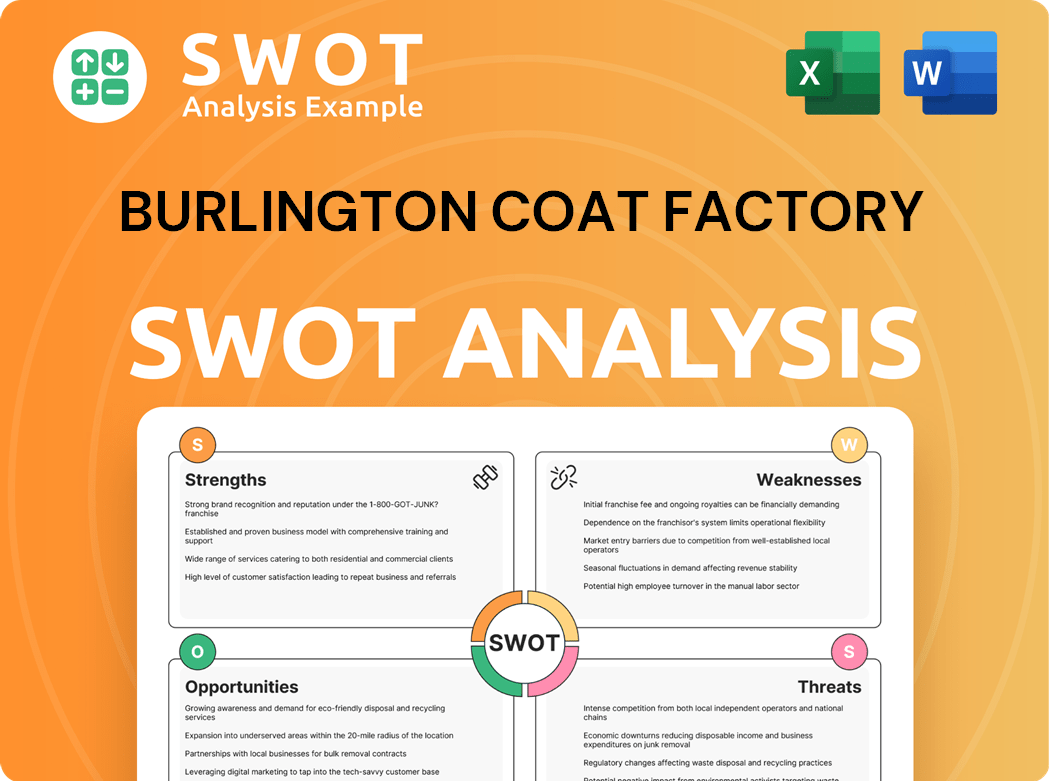
How Has Burlington Coat Factory’s Ownership Changed Over Time?
The ownership of Burlington Coat Factory, now known as Burlington Stores, has seen several key shifts since its inception. Initially a publicly traded company after its 1983 IPO, it later transitioned to private ownership. In 2006, Bain Capital Partners acquired the company for $2.06 billion, a significant event that reshaped the company's structure. At the time of the acquisition, the Milstein family, who were early investors, received approximately $1.3 billion for their nearly 30 million shares. This period marked a pivotal change in the company's trajectory, influencing its strategic direction and operational focus.
The company's journey continued with a return to the public market in 2013 through an Initial Public Offering (IPO) on the New York Stock Exchange (NYSE) under the ticker symbol 'BURL'. The IPO was successful, with the stock price increasing significantly on its first day of trading. Following the IPO, Bain Capital maintained a controlling stake, classifying Burlington as a 'controlled company' under NYSE standards. This transition back to public trading allowed for renewed investment and growth opportunities, shaping the company's financial performance and market position.
| Event | Date | Impact |
|---|---|---|
| Initial Public Offering | 1983 | Publicly traded company. |
| Bain Capital Acquisition | 2006 | Private ownership for $2.06 billion. |
| Second Initial Public Offering | 2013 | Return to public trading on the NYSE. |
As of June 2025, the ownership structure of Burlington Stores is primarily a mix of institutional and individual investors. Institutional investors, including mutual funds and hedge funds, hold substantial positions in the company. The company's financial performance has shown growth, with total sales increasing by 11% in fiscal year 2024, reaching $9.7 billion for the fiscal year ending January 2024. This performance reflects the company's strategic direction under its current ownership and management. For more details, you can read the Brief History of Burlington Coat Factory.
Burlington's ownership has evolved significantly, from public to private and back to public. Institutional investors currently hold a significant portion of the company's shares.
- Bain Capital played a key role in a major ownership shift.
- The company's financial performance shows growth.
- Institutional investors are major stakeholders.
- The company's stock is traded on the NYSE under the symbol 'BURL'.
Burlington Coat Factory PESTLE Analysis
- Covers All 6 PESTLE Categories
- No Research Needed – Save Hours of Work
- Built by Experts, Trusted by Consultants
- Instant Download, Ready to Use
- 100% Editable, Fully Customizable
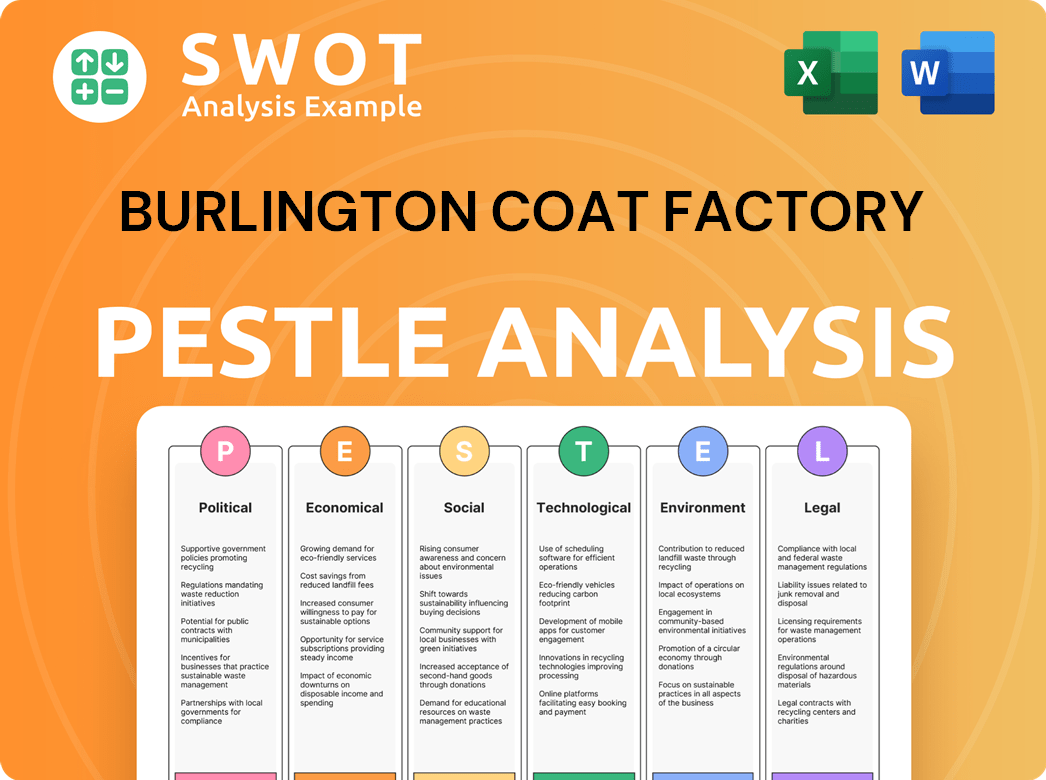
Who Sits on Burlington Coat Factory’s Board?
As of November 2024, the Board of Directors of Burlington Stores, Inc. includes Chairman John Mahoney and CEO Michael O'Sullivan. Michael O'Sullivan has been the CEO and a Director since September 2019, with a total yearly compensation of $15.40 million. Other key figures include Jennifer Vecchio, serving as Group President and Chief Merchandising Officer, and Travis Marquette as President and Chief Operating Officer.
The Board is committed to strong corporate governance, with a majority of independent directors. In 2018, 8 out of 9 directors were independent, and 3 out of 9 were female. Effective January 1, 2025, Shira Goodman, former CEO of Staples, Inc., joined the Board and its Audit Committee, bringing extensive retail experience. This composition reflects a focus on diverse perspectives and expertise to guide the company's strategic direction. For more insights, see Revenue Streams & Business Model of Burlington Coat Factory.
| Board Member | Title | Yearly Compensation (USD) |
|---|---|---|
| John Mahoney | Chairman | N/A |
| Michael O'Sullivan | CEO and Director | $15.40 million |
| Jennifer Vecchio | Group President and Chief Merchandising Officer | N/A |
| Travis Marquette | President and Chief Operating Officer | N/A |
| Shira Goodman | Director | N/A |
Burlington Stores operates with a one-share, one-vote principle for its common stock. For director elections, a plurality of votes cast is required. In uncontested elections, a majority voting policy is in place, requiring any director not receiving a majority of votes to tender their resignation. The Board's guidelines emphasize no unequal voting rights and clear stock ownership guidelines for key executives and non-employee directors. There have been no significant recent proxy battles or activist investor campaigns affecting decision-making.
The Board of Directors oversees the business and affairs of Burlington Stores, Inc., including strategic and risk management. The Board is committed to strong corporate governance. The voting structure generally follows a one-share, one-vote principle.
- John Mahoney is the Chairman.
- Michael O'Sullivan is the CEO.
- Shira Goodman joined the Board in January 2025.
- The Board emphasizes no unequal voting rights.
Burlington Coat Factory Business Model Canvas
- Complete 9-Block Business Model Canvas
- Effortlessly Communicate Your Business Strategy
- Investor-Ready BMC Format
- 100% Editable and Customizable
- Clear and Structured Layout
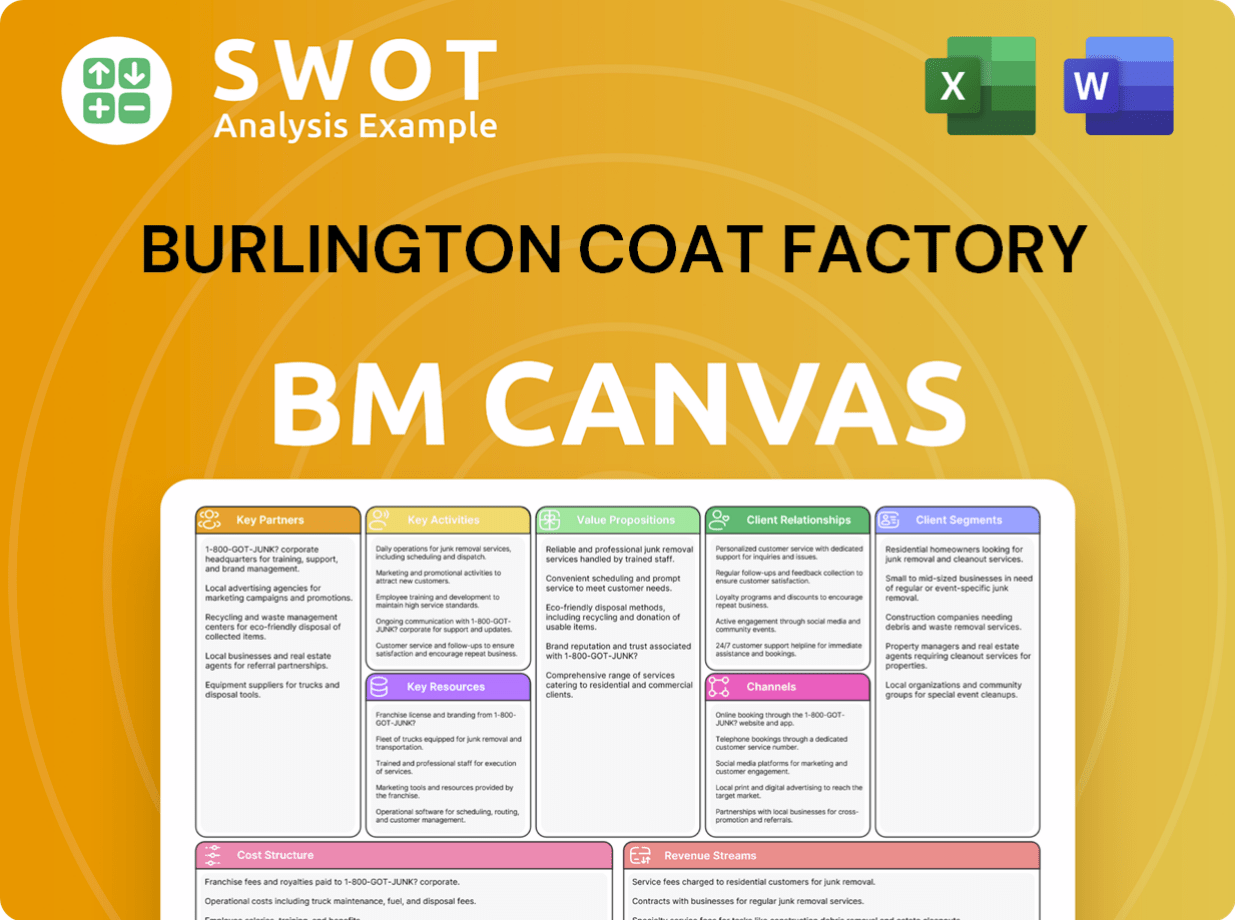
What Recent Changes Have Shaped Burlington Coat Factory’s Ownership Landscape?
In the past few years, the ownership and strategic direction of Burlington Stores have seen notable developments. For the fiscal year ending January 2024, the company reported net sales of $9.7 billion, marking an 11% increase from the previous year. Looking ahead to fiscal year 2025, the company anticipates further growth, projecting a 6% to 8% increase in total sales and a 0% to 2% rise in comparable store sales. This performance reflects the ongoing evolution of the company's business model and its response to market dynamics. The company's focus on strategic initiatives and financial management continues to shape its trajectory in the retail sector.
One key aspect of Burlington's recent financial strategy has been its active share buyback program. During the first quarter of fiscal year 2025, the company repurchased 445,285 shares of its common stock for $105 million. Moreover, the Board of Directors authorized the repurchase of up to an additional $500 million of common stock through May 2027. For the quarter ending March 31, 2025, share buybacks amounted to $127.563 million, which underscores the company's commitment to enhancing shareholder value. The buyback yield for fiscal years ending January 2021 to 2025 averaged 1.4%, with a peak of 2.0% in January 2023, highlighting the company's capital allocation priorities.
| Metric | Fiscal Year Ending | Amount |
|---|---|---|
| Net Sales | January 2024 | $9.7 billion |
| Share Repurchases (Q1 2025) | March 31, 2025 | $105 million |
| Share Buybacks (Q1 2025) | March 31, 2025 | $127.563 million |
In terms of leadership and operational strategy, Burlington is also focused on expansion. The company is targeting approximately 100 net new store openings for 2025 and aims for 500 net new stores between 2024 and 2028. This expansion strategy includes acquiring existing retail spaces, as seen with the acquisition of leases for over 40 closed Bed Bath & Beyond locations in June 2023 and 15 Conn's locations in 2024. These moves indicate Burlington's strategic approach to growth and its ability to capitalize on market opportunities. For further insights into Burlington's growth strategy, consider exploring the Growth Strategy of Burlington Coat Factory.
Burlington Stores, Inc. is a publicly traded company. The ownership is distributed among institutional investors, and individual shareholders.
The parent company of Burlington is Burlington Stores, Inc. (NYSE: BURL). The company operates as an off-price retailer.
Founded in 1972 as Burlington Coat Factory, the company has evolved. It expanded beyond coats to offer a wide range of apparel and home goods.
Michael O'Sullivan is the current CEO of Burlington Stores, Inc. His leadership plays a key role in the company's strategic direction and performance.
Burlington Coat Factory Porter's Five Forces Analysis
- Covers All 5 Competitive Forces in Detail
- Structured for Consultants, Students, and Founders
- 100% Editable in Microsoft Word & Excel
- Instant Digital Download – Use Immediately
- Compatible with Mac & PC – Fully Unlocked
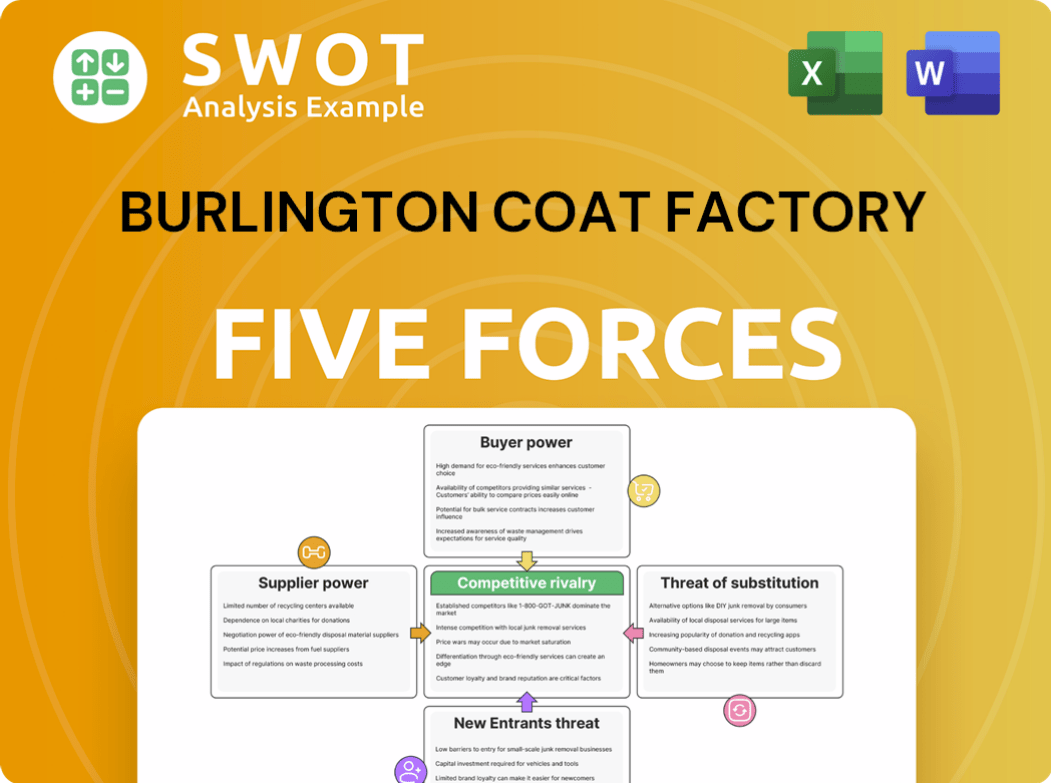
Related Blogs
- What are Mission Vision & Core Values of Burlington Coat Factory Company?
- What is Competitive Landscape of Burlington Coat Factory Company?
- What is Growth Strategy and Future Prospects of Burlington Coat Factory Company?
- How Does Burlington Coat Factory Company Work?
- What is Sales and Marketing Strategy of Burlington Coat Factory Company?
- What is Brief History of Burlington Coat Factory Company?
- What is Customer Demographics and Target Market of Burlington Coat Factory Company?
Disclaimer
All information, articles, and product details provided on this website are for general informational and educational purposes only. We do not claim any ownership over, nor do we intend to infringe upon, any trademarks, copyrights, logos, brand names, or other intellectual property mentioned or depicted on this site. Such intellectual property remains the property of its respective owners, and any references here are made solely for identification or informational purposes, without implying any affiliation, endorsement, or partnership.
We make no representations or warranties, express or implied, regarding the accuracy, completeness, or suitability of any content or products presented. Nothing on this website should be construed as legal, tax, investment, financial, medical, or other professional advice. In addition, no part of this site—including articles or product references—constitutes a solicitation, recommendation, endorsement, advertisement, or offer to buy or sell any securities, franchises, or other financial instruments, particularly in jurisdictions where such activity would be unlawful.
All content is of a general nature and may not address the specific circumstances of any individual or entity. It is not a substitute for professional advice or services. Any actions you take based on the information provided here are strictly at your own risk. You accept full responsibility for any decisions or outcomes arising from your use of this website and agree to release us from any liability in connection with your use of, or reliance upon, the content or products found herein.